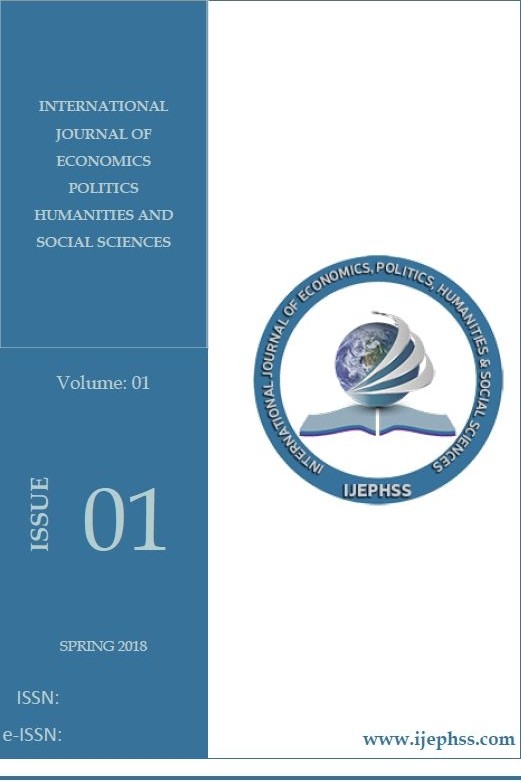TÜRKİYE’DE ENFLASYON VE FAİZ İLİŞKİSİNİN TESPİT EDİLMESİ: ARDL SINIR TESTİ YAKLAŞIMI
Ülke ekonomilerinde enflasyon ve faiz oranı göstergesi temel makroekonomik göstergeler arasında yer almaktadır. Söz konusu göstergeler arasındaki ilişki sıklıkla Fisher etkisi ile incelenmektedir. Bu çalışmada Türkiye ekonomisinde Fisher etkisinin geçerliliği 1987-2020 dönemine ait yıllık faiz ve enflasyon oranı değişkenleri ile araştırılmaktadır. Modeldeki değişkenlerin birim kök sınamasında yapısal kırılmaya izin veren Zivot ve Andrews (1992) birim kök testinden yararlanılmıştır. Modeldeki serilerin farklı dereceden durağan olmasından dolayı değişkenler arasındaki eşbütünleşme ilişkisi ARDL sınır testi ile incelenmiştir. ARDL sınır testi kısa dönem sonuçlarına göre; enflasyonun kısa dönemli etkisi istatistiki olarak anlamsız iken; uzun dönem sonuçları incelendiğinde ise enflasyonun etkisi istatistiki olarak anlamlı çıkmıştır. Çalışma sonucunda enflasyonun faizi artırdığı bulgusuna ulaşılmıştır. İncelenen dönemde Türkiye ekonomisinde tam Fisher etkisinin geçerli olduğuna yönelik bir sonuç elde edilmiştir.
Anahtar Kelimeler:
Enflasyon Oranı, Faiz Oranı, Fisher Etkisi, ARDL Sınır Testi, Türkiye Ekonomisi
DETERMINING THE RELATIONSHIP OF INFLATION AND INTEREST IN TURKEY: ARDL LIMIT TEST APPROACH
Inflation and interest rate indicators are among the basic macroeconomic indicators in national economies. The relationship between these indicators is often examined with the Fisher effect. In this study, the validity of the Fisher effect in the Turkish economy is investigated with the annual interest and inflation rate variables for the 1987-2020 period. Zivot and Andrews (1992) unit root test, which allows structural break in the unit root test of the variables in the model, was used. Since the series in the model are stationary at different degrees, the cointegration relationship between the variables was examined with the ARDL boundary test. According to the ARDL boundary test short-term results; while the short-term effect of inflation is statistically insignificant; When the long-term results are examined, the effect of inflation is statistically significant. As a result of the study, it was found that inflation increased the interest rate. In the examined period, a result was obtained that the full Fisher effect is valid in the Turkish economy.
Keywords:
Interest Rate, Inflation Rate, Fisher Effect, ARDL Boundary Test, Turkish Economy,
___
- Altunöz, U. (2018). Investigating the Presence of Fisher Effect for the China Economy, Sosyoekonomi, 26(35):27-40.
- Aydoğan, E. (2004). 1980'den Günümüze Türkiye'de Enflasyon Serüveni, Yönetim ve Ekonomi: Celal Bayar Üniversitesi İktisadi ve İdari Bilimler Fakültesi Dergisi, 11(1):91-110.
- Banerjee, A., Dolado, J. & Mestre, R. (1998). Error-correction Mechanism Tests for Cointegration in a Single-equation Framework, Journal of Time Series Analysis, 19(3):267-283.
- Berument, H. & Jelassi, M.M. (2002). The Fisher Hypothesis: A Multi-Country Analysis. Applied Economics, (34), 1645-1655.
- Brown, R. L., Durbin, J. & Evans, J. M. (1975). Techniques for Testing the Constancy of Regression Relationships Over Time, Journal of the Royal Statistical Society: Series B (Methodological), 37(2):149-163.
- Demirgil, B., & Türkay, H. (2018). Enflasyon-Faiz İlişkisi Bir ARDL/Sınır Testi Uygulaması, Hitit Üniversitesi Sosyal Bilimler Enstitüsü Dergisi, 11(1):515-528.
- Doğan, B., Eroğlu, Ö. & Değer, O. (2016). Enflasyon ve Faiz Oranı Arasındaki Nedensellik İlişkisi: Türkiye Örneği, Çankırı Karatekin Üniversitesi İİBF Dergisi, 6(1):405-425.
- Engle, R. F. & C. W. J. Granger, (1987). Cointegration and Error Correction: Representation, Estimation and Testing, Econometrica, 55:251-276.
- Fama, E. F. (1975). Short Term Interest Rates as Predictors of Inflation, American Economic Review, 65:269-282.
- Fisher, I. (1930). The Theory of Interest, The Macmillan Company, New York.
- Gül, E. & Açıkalın, S. (2007). An Examination of the Fisher Hypothesis: The Case of Turkey, Applied Economics, 10(1):1-5.
- International Monetary Found, (2021). 11.12.2021, https://www.imf.org/en/Data
- İncekara, A., Demez, S. & Ustaoğlu, M. (2012). “Türk Ekonomisi için Fisher Etkisinin Geçerliliği: Eşbütünleşme Analizi”, 8. Uluslararası Stratejik Yönetim Konferansı (58):396-405.
- Johansen, S. & Juselius, K. (1990). Maximum Likelihood Estimation and Inference on Cointegration with Applications to the Demand for Money, Oxford Bulletin of Economics and Statistics, 52(2):169-210.
- Johansen, S. (1988). Statistical Analysis of Cointegration Vectors, Journal of Economic Dynamics and Control, 12(2-3):231-254.
- Maghyereh, A. & Al-Zoubi, H. (2006). Does Fisher Effect Apply in Developing Countries: Evidence From a Nonlinear Cotrending Test Applied to Argentina, Brazil, Malaysia, Mexico, South Korea and Turkey, Applied Econometrics and International Development, 6(2):31-46.
- Mankiw, N. G. (2006) Macroeconomics, Seventh Edition, New York, NY: Worth Publishers.
- Özbek, S. (2020). Fisher Etkisi: Yükselen Piyasa Ekonomileri Üzerine Bir Uygulama, International Journal of Economics, Politics, Humanities & Social Sciences, 3(4):240-251.
- Perron, P. (1989). The Great Crash, the Oil Price Shock, and the Unit Roothypothesis, Econometrica: Journal of the Econometric Society, 1361-1401.
- Pesaran, M. H., Shin, Y. & Smith, R. J. (2001). Bounds Testing Approaches to the Analysis of Level Relationships, Journal of Applied Econometrics, 16:289-326.
- Sağlam, Y. (2018). Fisher Hipotezi’nin Fourier Yaklaşımı ile Testi: Gelecek-11 Ülke Grubu Örneği, Yaşar Üniversitesi E-Dergisi, 13 (52):316-321.
- Şimşek, M. & Kadılar, C. (2006). Fisher Etkisinin Türkiye Verileri ile Testi, Doğuş Üniversitesi Dergisi, 7(1):99-111.
- TCMB, (2021). Enflasyonun Nedenleri. 11.12.2021, https://www.tcmb.gov.tr/wps/wcm/connect/TR/TCMB+TR/Main+Menu/Temel+Faaliyetler/Para+Politikasi/Fiyat+Istikrari+ve+Enflasyon/Neden
- Turgutlu, E. (2004). Fisher Hipotezinin Tutarlılığının Testi: Parçalı Durağanlık ve Parçalı Koentegrasyon Analizi, Dokuz Eylül Üniversitesi İİBF Dergisi, 19(2):55-74.
- Türkmen, S. & Özbek, S. (2021). “Philips Eğrisi: Gelir Grupları İtibariyle Betimsel Bir Analiz”, (Ed. Şahin Karabulut), Teoride İktisadi ve Mali Finansal Uygulama ve Anlayışlar, 1-14, Gazi Kitapevi, Ankara.
- Uçak, H., İlhan, Ö. & Aslan, A. (2014). An Examination of Fisher Effect for Selected New EU Member States, Internatıonal Journal of Economics and Financial Issues, 4(4):956-959.
- World Bank, (2021), 11.12.2021, https://databank.worldbank.org/source/world-development-indicators#
- Yılancı, V. (2009). Fisher Hipotezinin Türkiye İçin Sınanması: Doğrusal Olmayan Eşbütünleşme Analizi, Atatürk Üniverisitesi İİBF Dergisi, 23(4):205-213.
- Zivot, E. & Andrews, D. W. K. (2002). Further Evidence on the Great Crash, the Oil-Price Shock, and the Unit-Root Hypothesis, Journal of Business & Economic Statistics, 20(1):25-44.
- Başlangıç: 2018
- Yayıncı: Onur OĞUZ
